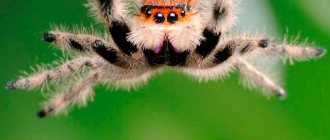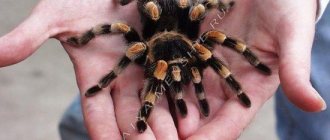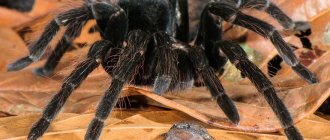How to make the right choice?
Terrestrial spider species are the best choice for beginners. They are less demanding in maintenance and much slower than woody ones. The best ones to pay attention to are the following species: Lasiodora parahybana, Brachypelma boehmei, Brachypelma albiceps, Brachypelma smithi. In general, the entire genus Brachypelma is considered one of the best for beginners. They are quite calm and their venom is less toxic than that of other species. If you want to get a tree spider, it is worth remembering that you need to be extremely careful with them, as they are capable of moving very quickly.
Where are spiders kept?
The best place for spiders to live in a house is considered to be a terrarium made of plastic or glass. The container must be hermetically sealed, but at the same time have good ventilation.
On a note! To create ideal living conditions, it is extremely important to know the natural living conditions of the selected spider - how long the pet will live depends on this.
The size of the terrarium depends on the size of the pet itself. For a young spider that has only survived a few molts, you can use a plastic container measuring 6x8x10 cm as a house, and for an adult tarantula you need a terrarium measuring 30x30x30 cm. It is better not to use large containers - the pet will feel discomfort in them.
Terrarium
Only one individual can be kept in one container. The babies are kept together until the first moult, and then they also need to be seated, otherwise injury and death of the pets may not be avoided.
Before you move your pet in, you need to properly prepare its house:
- Spiders need moisture to thrive. To do this, you need to periodically moisten the substrate through a watering can or syringe without a needle (but not with a spray). In this case, moisture should not get on the pet.
- There should be a layer of substrate at the bottom.
- Ventilation and tightness. This means that the container must close well, but at the same time air must flow freely into it. To do this, you need to have a terrarium with small multiple holes on the lid.
- Tarantulas do not need lighting - they are nocturnal inhabitants.
- Tarantulas are not too picky about temperature indicators, but it is best if the temperature in the house is maintained at +22…26 °C.
Diseases, treatment and prevention
Diseases affecting tarantulas are currently classified as insufficiently studied, so there is no established practice for their treatment. The most common cause of death for a spider living in captivity is severe dehydration, so the substrate must be constantly and sufficiently well moistened.
The tarantula may also die as a result of injury or severe bruising . To prevent your exotic home from falling from a great height, it is very important to use a cover with small but numerous ventilation holes to cover the terrarium. In order to treat the wound caused by arthropods, regular petroleum jelly is used.
Several types of mites can parasitize spiders, but the greatest danger to exotics is posed by predatory ectoparasites, which infect the lungs of the arthropod and cause a fairly rapid death of such a pet. For preventive purposes, a complete replacement of the substrate in the terrarium should be carried out every six months. Internal parasites, represented by nematodes, cause no less harm to the spider, so it is very important to keep the tarantula’s home clean.
Is it possible to pick it up?
It is not prohibited to pick up a spider; the main thing is to tame the animal so that it does not cause stress to it. When stressed, a spider may attack you and even bite you. Therefore, tarantulas need to be tamed gradually and immediately after purchase. The animal must understand that you will not harm it; to do this, you must first gently stroke it on the back. Gradually, the pet will reach out to the hand and begin to climb on it. At this time, the main thing is to ensure that your pet does not run away, since in most cases the animal will disappear without a trace.
Reproduction
The sex of a tarantula spider is easy to determine if you follow the recommendations of experts. Young spiders begin to molt after about a month. After molting, the skin is taken and carefully examined. In the posterior region of females there is a depression, and in males there are something like two tubercles. If the individuals are adults, then the sex can be determined by appearance. Males have slightly slimmer legs and are taller, while the body is significantly smaller in size than the female.
After mating, the eggs develop inside the female for 2 months. During this period, she must form a special cocoon. At one time, she can lay up to 500 eggs, while about 50 spiders remain alive. In order for the juveniles to actively develop, the cocoon is moved to a separate terrarium, thereby creating certain temperature conditions.
For the first month, baby spiders do not eat anything, until the first molt. Until this moment, they can be together, after which they are separated one by one. A female tarantula spider molts up to 12 times during her entire life. Males stop moulting immediately after puberty.
Interesting to know ! The tarantula spider is constantly growing and maturing, which is why it needs to shed its “old clothes”. Before molting, individuals turn over on their backs, trying to remove their old skin. At the same time, he completely stops eating. After molting, the spider gets a new color, and the pile is completely renewed.
Comfortable humidity:
Tropical spiders feel comfortable only in 90% humidity, so the terrarium needs to be generously irrigated with a spray bottle of warm water every day;
semi-desert spiders are comfortable with a humidity of 70-80%; to ensure this parameter, it is enough to place a drinking bowl with a large amount of water in the terrarium.
To provide the spider with a comfortable temperature and humidity, you can buy universal measuring instruments at the same pet store or hardware store and place them inside the terrarium.
Antidote
The most effective drug was considered to be antikarakurt serum produced by the Tashkent Bacteriological Institute. Good results were obtained with the administration (intravenous) of calcium chloride, novocaine and magnesium hydrogen sulfate.
If the person bitten is away from the medical center, it is recommended to cauterize the affected area with a lit match head within the first two minutes. It is believed that the poison, which does not have time to penetrate deeply, is destroyed by exposure to high temperature.
The karakurt spider is especially dangerous for small children. If help is late, the child cannot be saved.
Animals die from close “contacts” with the black widow, among which camels and horses are considered the most vulnerable.
Precautionary measures
The most poisonous tarantula on our planet is the incredibly beautiful and bright arboreal metal tarantula (Poecilotheria metallica). This is a very strong and fast, aggressive and completely unpredictable arthropod, the distinctive feature of which is the ability to jump high.
The venom of this species is very toxic, and a bite can cause severe pain, increased heart rate, increased sweating, migraines, muscle cramps or severe weakness in humans. However, as practice shows, a fatal outcome is unlikely. Despite the fact that the woody metal tarantula spider is very rare and is listed in the International Red Book, it is sometimes found in the collections of connoisseurs of exotic arthropods.
Is it better to get a male or a female?
It all depends on the wishes of the owner himself. For those who want to watch the happy life of a pet for a long time, it is better to get a female. In this case, it will be cheaper to purchase a male spider.
House Spider: Pros and Cons
The advantages of keeping spiders in your home include the following:
- Place. Spiders are ideal pets for anyone who doesn't have a large apartment.
- Quiet and clean. Spiders do not make any sounds, are clean, and do not smell.
- Time. Caring for tarantulas is almost minimal. It is necessary to rarely clean his home; the substrate needs to be changed every six months. This pet is perfect for those who often have to stay late at work or go on business trips for several days: by providing the spider with water and food, you can avoid appearing at home for at least a week.
- Attention. Tarantulas do not need communication, they do not need to be stroked, talked to, walked, etc.
- Financial expenses. It is necessary to feed spiderlings once every 2 days, and adults once every 7-10 days. Before molting begins, spiders generally refuse food. In other words, the spider’s feeding will not cause serious damage to its owner’s budget.
Pet
Unfortunately, there are also disadvantages of keeping such pets:
- They may escape from a terrarium or container.
- They may bite.
- They are not trainable.
- They do not get used to the owner - even after 10 years the spider will not recognize the person who has been caring for it all this time.
Important! Any manipulations in the terrarium must be performed very carefully and only with the help of long tweezers.
Eating at home
Despite the obvious name, birds appear on the spider menu randomly. Since tarantulas are predators by nature, their diet should consist of live food.
While at home, young spiders eat various insects (flies, mosquitoes, cockroaches, locusts, crickets, etc.).
An adult tarantula should be offered:
- frogs.
- small mice.
- chicks.
- caterpillars, mealworms.
- fish.
- little snakes.
Important: the size of the food should be 2-3 times smaller than the pet . Since tarantulas are more active at night, they should be fed after dark.
What else can you feed tarantulas, and what should not be offered to the spider, a specialized store will tell you.
Since tarantulas are overly passive, after feeding they are able to remain motionless for a long time. It is not recommended to overfeed the spider due to its low activity, otherwise health problems cannot be avoided.
The optimal frequency of meals for an adult tarantula is 2 times a week. Young animals need food more often - every 2-3 days. It is important to take into account the types of spider.
The pet's position "lying on its back" and the absence of any activity indicate the beginning of molting.
Since restoration of the tarantula’s internal organs occurs during this period, it is advisable to temporarily postpone feeding it with live food to avoid possible damage. It is recommended to offer food to the spider 5-6 days after the complete shedding of the external skeleton.
Reviews from tarantula owners
The tarantula spider cannot be raised, trained or tamed in the sense of such words that are familiar to owners of exotics . Even a very calm tarantula may well bite its owner if it suddenly senses danger.
This is interesting! Experienced spider keepers recommend performing all manipulations related to maintaining the terrarium using special, fairly long tweezers.
As the owners note, tarantulas, which were surrounded by attention in childhood and were often picked up, are most relaxed about their surroundings and their owner.
LIZARD: DESCRIPTION, PHOTO, REPRODUCTION, SPECIES, FOOD, LIFESTYLE
CHAMELEON: LIFESTYLE, HABITAT, PHOTO, SPECIES, REPRODUCTION, HUNTING
IGUANA: CARE AND MAINTENANCE AT HOME, PHOTO, DESCRIPTION
Setting up a terrarium
In order for your new pet to live happily ever after, no special conditions are required - a modest terrarium is quite enough. Spiders are gloomy ascetics and spend most of the time allotted for themselves sitting in one place, only occasionally making “jogs” to stretch their legs. A cozy spider house with optimal dimensions is a terrarium equal to two lengths of the full span of its legs, that is, even the largest spider will feel great in a living space of 40x40cm.
But do not forget that spiders can move quite well on vertical surfaces, so the main thing is a reliable lid that will close well and keep the poisonous pet in its rightful square centimeters.
Let's move on to creating optimal conditions for the spider.
- Substrate. It is necessary to “cover the floor” in the spider’s home with a special flooring. The ideal option is vermiculite, a special mineral rock that is used in crop production. Layer - from 3 to 5 cm. If you can’t find one, you can also use coconut substrate or regular peat. By the way, it is recommended to mix the latter with sphagnum moss. As a last resort, when there is absolutely nothing, garden soil will do (only from a flower shop and in no case from the nearest flower bed!) or soil used for growing indoor plants. However, it is advisable to use this option for a short time and try to quickly replace it with a substrate more suitable for the spider.
- Temperature. Spiders are thermophilic and prefer to stay in a temperature range that will be close to +22…28°C. These pets are immune to a slight short-term decrease in temperature, but it is undesirable to abuse such situations. But at the same time, it is not recommended to overheat the terrarium. This situation is especially dangerous for well-fed animals, in which the process of rotting undigested food may begin in the stomach.
- Lighting. For spiders, which are nocturnal inhabitants, the natural light in the room is sufficient. No additional sources are needed. Moreover, direct light from a lamp can quickly destroy this fragile creature.
- Humidity. A drinking bowl and the right substrate help to some extent to ensure its optimal level. If the readings on the hygrometer are too low, then from time to time you will have to irrigate the terrarium with water from a spray bottle. But again, high humidity is dangerous, so when buying a spider, immediately find out from the seller what humidity is needed specifically for this species.
- Filling. For a spider in a terrarium, the main thing is a shelter in which it can hide during daylight hours, and if you keep a burrowing species, then a “house” is simply a must for it. Without it, such a pet will be in constant stress. Setting up such a shelter is very simple - you can lean a piece of bark, a coconut shell against the wall, put an inverted half of a flower pot in the corner, etc. Everything else, such as decorative driftwood, artificial plants and other similar elements, is unnecessary. Spiders are completely indifferent to them, so you purchase and install such accessories exclusively for yourself.
How many years do they live
Of course, the life expectancy of a pet will depend on how well you can create conditions for it. However, in general, with good care, spiders of various species have the following life expectancy:
- tarantulas - live on average 15-20 years;
- tarantulas - life expectancy greatly depends on the species, some in captivity live only 1-2 years, but there are varieties that can live up to 20-30 years (females live longer than males);
- cross - they live for a maximum of six months, males die after mating, females - after creating a cocoon;
- jumper - in captivity, females live up to 3 years, males live 1-2 years;
- peacock spider - lives a maximum of 9 months;
- goliaths - females live up to 8-9 years, males - up to 6 years.
The general pattern is this: large species have a longer lifespan than small species.











